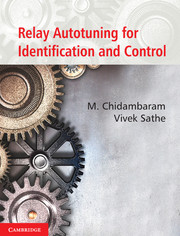Book contents
- Frontmatter
- Contents
- List of Figures
- List of Tables
- Acknowledgements
- Preface
- 1 Introduction
- 2 Improved Autotune Identification Methods
- 3 Cascade Controllers Tuning by Relay Autotune Method
- 4 Simultaneous Relay Autotuning of Cascade Controllers
- 5 A Simple Method of Tuning Cascade Controllers
- 6 Improved Saturation Relay Test for Systems with Large Dead Time
- 7 Identification of FOPTD Model using Single Symmetrical Relay Test
- 8 Autotuning of PID Controllers for Unstable FOPTD Systems
- 9 Autotuning of PID Controllers for Critically Damped SOPTD Systems
- 10 Estimation of SOPTD Transfer Function Model
- 11 Estimation of Five Parameters of Unstable SOPTD Model with a Zero
- 12 Identification of FOPTD Multivariable Systems
- 13 Identification of SOPTD Multivariable Systems
- 14 Tuning of Multivariable Controllers for Non-Minimum Phase Systems
- 15 Tuning of Multivariable Controllers by Genetic Algorithms
- 16 Summary and Conclusions
- Appendix A
- Appendix B
- Appendix C
- Nomenclature
- Problems
- Suggestive Reading
- References
- Index
7 - Identification of FOPTD Model using Single Symmetrical Relay Test
Published online by Cambridge University Press: 05 June 2014
- Frontmatter
- Contents
- List of Figures
- List of Tables
- Acknowledgements
- Preface
- 1 Introduction
- 2 Improved Autotune Identification Methods
- 3 Cascade Controllers Tuning by Relay Autotune Method
- 4 Simultaneous Relay Autotuning of Cascade Controllers
- 5 A Simple Method of Tuning Cascade Controllers
- 6 Improved Saturation Relay Test for Systems with Large Dead Time
- 7 Identification of FOPTD Model using Single Symmetrical Relay Test
- 8 Autotuning of PID Controllers for Unstable FOPTD Systems
- 9 Autotuning of PID Controllers for Critically Damped SOPTD Systems
- 10 Estimation of SOPTD Transfer Function Model
- 11 Estimation of Five Parameters of Unstable SOPTD Model with a Zero
- 12 Identification of FOPTD Multivariable Systems
- 13 Identification of SOPTD Multivariable Systems
- 14 Tuning of Multivariable Controllers for Non-Minimum Phase Systems
- 15 Tuning of Multivariable Controllers by Genetic Algorithms
- 16 Summary and Conclusions
- Appendix A
- Appendix B
- Appendix C
- Nomenclature
- Problems
- Suggestive Reading
- References
- Index
Summary
Using a single symmetric relay feedback test, a method is proposed to identify all the three parameters of a first order plus time delay (FOPTD) model. On identifying a higher order dynamics system by an FOPTD model, the conventional method identifies a negative time constant (Li et al., 1991) due to the error in neglecting higher order dynamics in the system output. In the present work, all the parameters of an FOPTD model are estimated with adequate accuracy. Four simulation examples are given. The estimated model parameters of an FOPTD model are compared with those obtained by Li et al. (1991) and also those with the exact model parameters of the system. The performance of the controller designed on the identified model is compared with that identified by Li et al. (1991) and with that of the actual process. The method gives results close to that of the actual system. Simulation results for stable and unstable systems are given.
Introduction
Identification of transfer function models from experimental data is essential for model based controller design. Often derivation of a rigorous mathematical model is difficult due to the complex nature of chemical processes. Hence, system identification is a valuable tool to identify low order models, based on the input-output data. The relay feedback is a single-shot experiment and the magnitude of oscillations can be varied. From the principal harmonics approximation, the ultimate gain (Ku) and ultimate frequency (ωu) are found.
- Type
- Chapter
- Information
- Relay Autotuning for Identification and Control , pp. 93 - 104Publisher: Cambridge University PressPrint publication year: 2014



